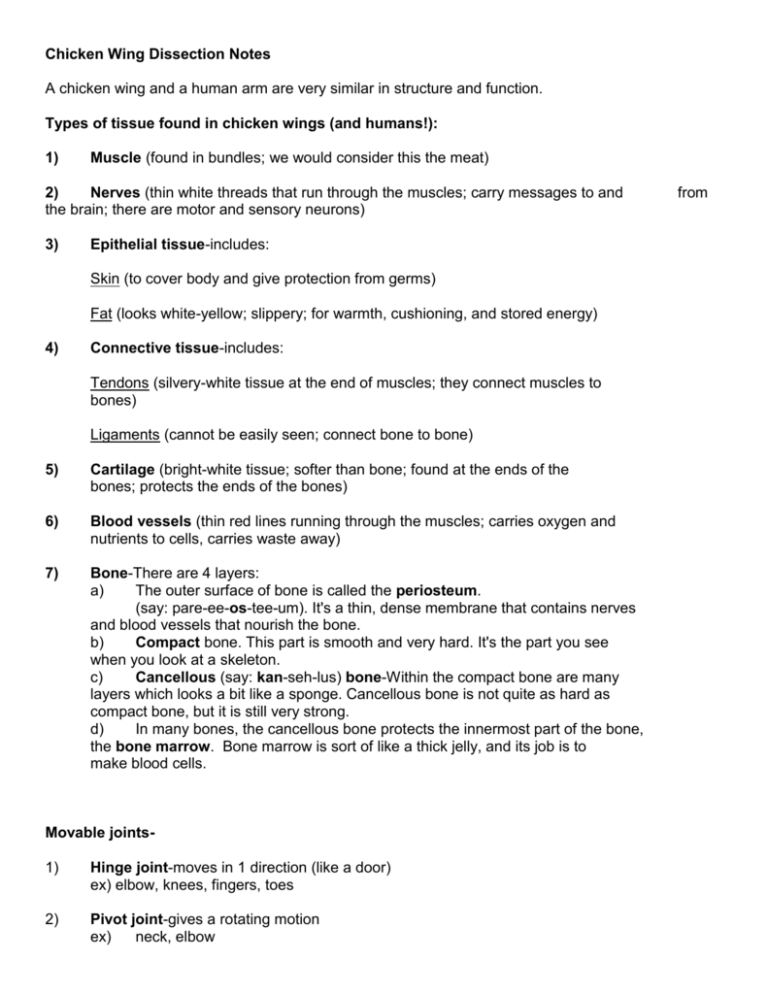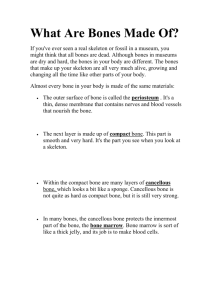Chicken Wing Dissection Notes: Anatomy & Joints
advertisement

Chicken Wing Dissection Notes A chicken wing and a human arm are very similar in structure and function. Types of tissue found in chicken wings (and humans!): 1) Muscle (found in bundles; we would consider this the meat) 2) Nerves (thin white threads that run through the muscles; carry messages to and the brain; there are motor and sensory neurons) 3) Epithelial tissue-includes: Skin (to cover body and give protection from germs) Fat (looks white-yellow; slippery; for warmth, cushioning, and stored energy) 4) Connective tissue-includes: Tendons (silvery-white tissue at the end of muscles; they connect muscles to bones) Ligaments (cannot be easily seen; connect bone to bone) 5) Cartilage (bright-white tissue; softer than bone; found at the ends of the bones; protects the ends of the bones) 6) Blood vessels (thin red lines running through the muscles; carries oxygen and nutrients to cells, carries waste away) 7) Bone-There are 4 layers: a) The outer surface of bone is called the periosteum. (say: pare-ee-os-tee-um). It's a thin, dense membrane that contains nerves and blood vessels that nourish the bone. b) Compact bone. This part is smooth and very hard. It's the part you see when you look at a skeleton. c) Cancellous (say: kan-seh-lus) bone-Within the compact bone are many layers which looks a bit like a sponge. Cancellous bone is not quite as hard as compact bone, but it is still very strong. d) In many bones, the cancellous bone protects the innermost part of the bone, the bone marrow. Bone marrow is sort of like a thick jelly, and its job is to make blood cells. Movable joints1) Hinge joint-moves in 1 direction (like a door) ex) elbow, knees, fingers, toes 2) Pivot joint-gives a rotating motion ex) neck, elbow from 3) Ball-in-socket joint-allows greatest motion ex) shoulder, hip 4) Gliding Joint-bones slide past each other ex) wrist, vertebrae Movable joints protected by: a) cartilage-protects from scraping/wearing and acts as shock absorber b) synovial fluid-keeps joint moist and lubricated Immovable Joint1) Bones of skull-these fuse in your first couple years Also, study your “Repetitive Stress Injury” reading assignment so you can explain what a repetitive stress injury is. Know what and where your carpal tunnels are, and what happens in your wrist when they cause problems. “Anabolic Steroid: Not Worth the Risk” Be able to list 3 problems steroids can cause Recall that we have 3 types of muscle: 1) Skeletal (helps our bones move, considered “voluntary”= can choose to move them) 2) Smooth (lines digestive tract) 3) Cardiac muscle-heart muscle








